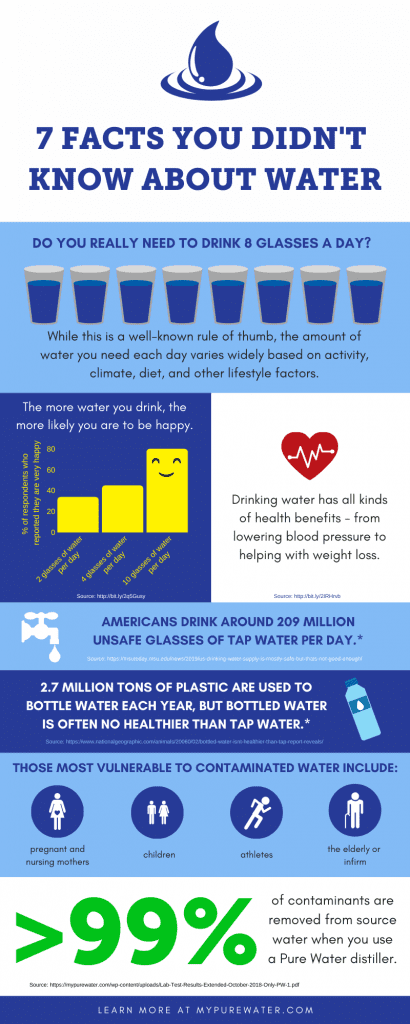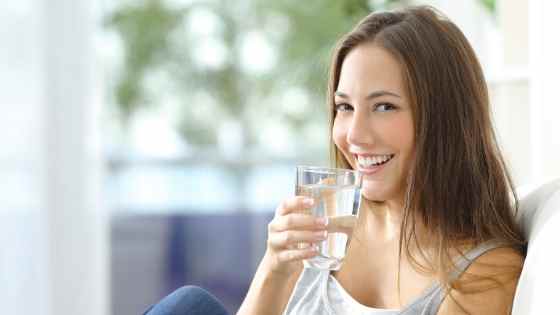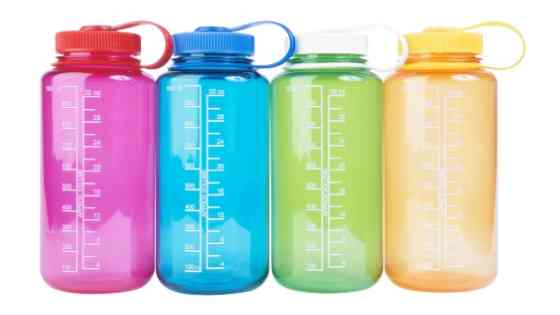Drinking water is in. It’s a HUGE social trend! Hydro Homies with their memes, VSCO girls with their hydroflasks, and even dedicated Twitter accounts and Apps will remind you to stay hydrated and drink water. Health gurus, YouTubers, coworkers, family, and friends all ask if you’re drinking enough water. And good news about this fashionable choice: staying hydrated looks great on everyone!
Choosing to drink water over less healthy drinks has been credited with both proven and unproven health claims. From helping to achieve weight loss goals, to releasing toxins, to improving one’s skin tone, many believe this seemingly simple drink is a cure-all. Drinking water has even been shown to make you happier!
Plus, you don’t want to get dehydrated! That’s a recipe for disaster. Physically, mild dehydration means reduced endurance, increased fatigue, trouble regulating body temperature, and less motivation. Mentally, mild dehydration affects your concentration, alertness and short-term memory. (Source)

Do you want in on this hydration trend? Here’s what you need to know:
Why Don’t We Drink Enough Water?
When people don’t drink enough water, it’s usually because they:
- don’t like the taste
- forget
- don’t feel thirsty
If you want to avoid making these excuses yourself, it helps to understand why people make these excuses.
When people say that they don’t like the taste of water, this actually refers to the taste of the contaminants commonly found in water. For example, iron tastes like metal. Some people get so used to the contaminants in their water that any other water tastes weird to them, and some just avoid water because they never liked the taste of the contaminants. Treat yourself to healthy drinking water by choosing vapor distilled water over reverse osmosis, filtered water, tap water or bottled water.
Others just forget to drink water. The elderly and those with dementia especially struggle with this, ignoring or no longer understanding their body’s cry for water.
Some people don’t feel thirsty due to medications, or they prefer other drinks like soda. Sometimes it takes commitment to override the craving for sugary drinks.
How To Drink Enough Water

If you’re committed to hydration, make it easy for yourself! You’ll be more likely to stick with it.
First, overcome the taste issue by choosing healthy, refreshing, delicious water. Pure water does not have an odor, a metallic or odd taste, or worse, visible particles floating in it.
Second, set reminders and track your intake so you don’t forget to drink water and so you that you consume enough.
Choose Healthy Drinking Water
Should I Drink Tap Water?
You may question whether to drink tap water because it is not pure water and may not be the healthiest drinking water. The only way to know what is in your water is to have it tested.
Look up Certified Drinking Water labs here.
While local municipalities often tout tap water as being safe, sometimes it is not, and often you won’t know until after you’ve consumed contaminants. The lead crisis in Flint, Michigan is one example. Plus, every two minutes, a water main bursts in the U.S. – which leads to water contamination, boil alerts, lack of access to water, closed businesses, and dozens of other problems.
Your local water is subject to leaks, water main breaks, periodic contamination from floods or other natural events, as well as man-made disasters like factory leaks, intentional or unintentional spills. In addition to this, modern farming practices are contaminating water systems around the country with herbicides, pesticides, and more. Lots of modern products and pharmaceuticals also make their way into the drinking water supply as water treatment systems were not designed to remove them.
It is important to note that most municipal water supplies contain some kinds of contaminants.
Discover the most common contaminants in your tap water here.
For most people, it has been deemed “safe.” But it’s not for everyone. Even our local water supply in Lincoln, Nebraska, comes with a warning:
“Some people may be more vulnerable to contaminants in drinking water than the general population. This includes immuno-compromised persons, such as those with cancer who are undergoing chemotherapy, those who have undergone organ transplants, people with HIV/AIDS or other immune system disorders, some elderly people, and infants. These customers and caregivers should seek advice about drinking water from their health care providers.”
Source: 2018 Water Quality Report Lincoln, Nebraska
Have you looked at the disclaimers on your local tap water report?
Is Bottled Water Safer than Tap Water?
You should know: Bottled water is not always safer than tap water.
Bottled water is mainly purchased for three reasons: convenience, taste, and lack of odor. If tap water tastes bad, has an odor or an odd color, then it makes sense that people would turn to bottled water. It is the quickest alternative, after all.
However, many brands of bottled water are just tap water. Some brands only partially filter their water. One study by NRDC found that 22% of bottled water tested had amounts of chemicals that exceeded state health limits.
If you want the convenience of bottled water, using a water distiller at home and a water bottle to carry it with you will yield better results and is much less expensive in the long run!
The main drawbacks of bottled water are the cost and the impact on the environment.
The Cost of Bottled Water
Plus, you have to add in the cost of transporting bottled water. It may appear at first glance to be more convenient, but how much time and money did you spend to go to the store? How much effort does it take to lug around?
Bottled Water and the Environment
Bottled water is not good for the environment. In 2019, 22 billion plastic bottles ended up in landfills or incinerators. About 75% of plastic water bottles end up in landfills, and it takes up to 500 years for water bottles to decompose.
Not only do we have to deal with all the waste, but making the bottles requires millions of barrels of oil per year and the cost of transport to the environment in the form of carbon dioxide.
According to Plastic News, “Bottled water, over the past decade, has increased by a compound annual growth rate of 5 percent.” If you care about plastic waste and our environment, then bottled plastic water is not the solution.
Is Electrolyte Water Good for You?
Drinking electrolyte water is not necessary for most people. Most electrolyte water is simply bottled water with added electrolytes. (Again, please keep in mind that buying bottled water will also produce a lot of unnecessary plastic waste.)
Electrolytes are made up of sodium, potassium, chloride, calcium, magnesium, phosphate, and bicarbonate. It is entirely possible to get your necessary electrolytes through a healthy diet! Salt, bananas, avocados, sweet potatoes, seeds, nuts, leafy green vegetables, and dairy products all give you electrolytes that your body can readily use.
And if you exercise a lot or are dehydrated from illness? Then you can consider these enhanced drinks or supplements to replenish electrolytes quickly. Otherwise, a good healthy diet is enough to keep your body in balance.
What is Alkaline Water? Should I drink that?
Alkaline water typically has a pH of 8 or 9, although some proponents recommend an even higher pH. Drinking alkaline water has become quite popular.
Many believe that you can alter the pH of one’s body by drinking it as alkaline water has a pH greater than 7. Advocates claim that it will help you increase your metabolism and energy, improve digestion, decrease bone loss, and even stave off cancer. Unfortunately, there isn’t much research to back these claims.
However, if you believe in the powers of alkaline water, you can make your own easily at home by adding just 1/8 tsp of baking soda per 8 oz of water. You don’t need to waste your money buying fancy alkaline water.
Should I Drink Distilled Water?
Yes, you should drink distilled water because it is the best, healthiest drinking water on Earth.
Drink distilled water because it has been boiled, evaporated (leaving the toxins behind), and recaptured in condensation. Distillation is an easy and natural process. It is so natural that you can make your own distilled water in the comfort of your own home. In essence, it is using the natural water cycle as the blueprint.
Once you remove contaminants, toxins, and even possible viruses or bacteria, you get odorless, colorless, particle-free water that tastes so clean and pure that you look forward to drinking it all day long. You’ll actually be able to see all the gunk that you didn’t absorb into your body; it’ll be left behind in the boiling tank of your distiller.
Distillation is most decidedly the best form of water purification.
So What Kind of Water is the Best to Drink?
At this point, it should be clear: Distilled water is the best kind of water to drink.
3rd-party laboratory testing proves that distilled water is virtually free of common contaminants such as nitrates, arsenic, chlorine, fluoride, lead, pesticides, uranium, and much more. It is healthy because it doesn’t introduce added chemicals to your system.
Distilled water is hydrating and refreshing. When you distill water at home, it is also the healthiest drinking water for the environment as there is no additional plastic waste being added to landfills or the oceans.
Learn more about why our water distillers are good for the environment.
Setting Reminders & Tracking Water Intake

So now that you know the best water to be drinking, we have to make sure you stick with it! Granted, freshly distilled water tastes delicious. That makes it easier to stay hydrated. But there are other steps you can take too.
First, determine how much water you need to be drinking every day. How much water do you, realistically, want to drink each day? How much does your body need?
The rule of thumb is 8 glasses of water a day, but if you live in a warmer climate and you exercise a lot, you may need more. If you live a sedentary lifestyle, you may need less.
Next, you need to be able to track how much water you’re actually drinking.
Lots of water bottles now have measurements printed on them, but if yours doesn’t, you can easily make your own tracking system. Take a measuring cup and put one cup of water into your water bottle. Mark where the water reaches with a rubber band. Repeat all the way up. Voila! You now can track your water intake.
And finally, set reminders in your phone or on an app. It’s easy to get caught up in our activities and forget to drink water. Check in once an hour or once every two hours to see if you’re meeting your goal. If you aren’t, don’t worry – you can catch up.
Ready to Get Started with Healthy Drinking Water?
If you have questions, please contact us at info@mypurewater.com or call us at 1.800.875.5915. Thanks!




That makes sees that you need more water in warmer climates. I am considering moving down south, so that’s good to know. I’ll make sure to drink more water.